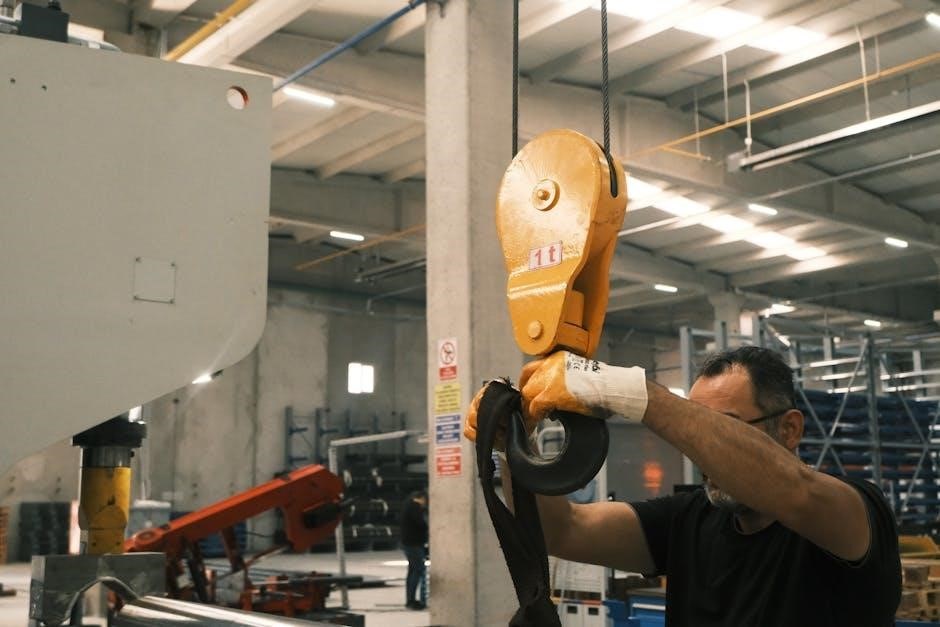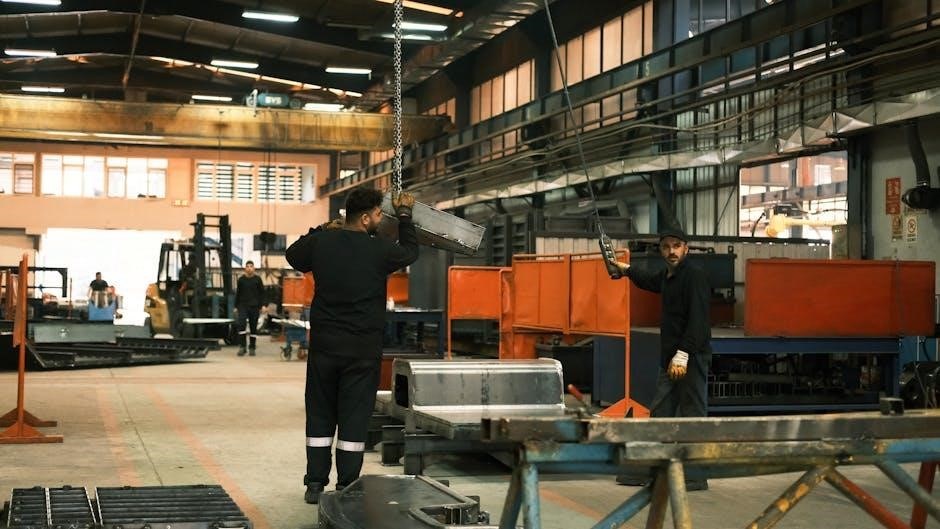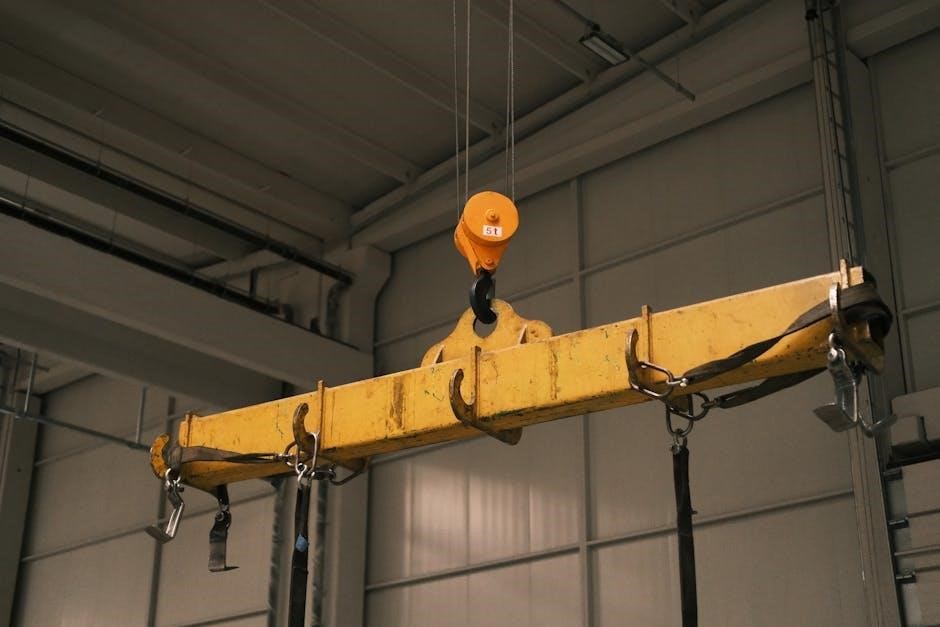A manual Hoyer lift is a essential tool for safely transferring individuals with mobility challenges. It enables caregivers to lift patients effortlessly, promoting dignity and reducing strain.
1.1. What is a Manual Hoyer Lift?
A manual Hoyer lift is a non-powered patient lifting device used primarily in healthcare settings. It relies on manual operation, such as hydraulic systems or winches, to lift patients safely. Designed for portability and cost-effectiveness, it is suitable for various environments like hospitals, nursing homes, and home care. The lift typically features a sturdy frame, patient-supporting straps or slings, and mechanisms for controlled lifting. Safety features, such as wide bases and locking wheels, ensure stability during transfers. While it requires physical effort from caregivers, it offers precise control and versatility, making it a practical choice for patient transfer needs.

Using a manual Hoyer lift involves preparing the device, positioning the patient, and ensuring safety during the transfer. Always follow manufacturer guidelines and consult a professional guide.
Before using a manual Hoyer lift, ensure the device is stable and free from damage. Check the base for even placement, wheels for smooth movement, and locking mechanisms for secure positioning. The sling should be properly attached and free from tears or frays. Verify the weight capacity matches the patient’s needs. Ensure the patient is wearing appropriate clothing and remove any loose items that could interfere with the transfer. Always refer to the manufacturer’s guidelines for specific pre-use inspections. Conducting these checks ensures safety and prevents accidents during the transfer process. Proper preparation is crucial for a smooth and incident-free experience for both the caregiver and the patient.
Using a manual Hoyer lift requires careful execution to ensure safety and comfort for both the patient and caregiver. Begin by positioning the lift near the patient, ensuring the base is stable and the wheels are locked. Gently roll the patient onto their side and slide the sling underneath them, making sure it is centered and secure. Return the patient to a flat position and attach the sling straps to the lift’s hooks. Slowly pump the hydraulic handle to lift the patient, maintaining control throughout the process. Once lifted, carefully push the lift to the desired location, such as a wheelchair or bed. Lower the patient by releasing the hydraulic mechanism slowly. Always prioritize smooth movements to avoid discomfort or injury.
A manual Hoyer lift is a vital assistive device designed to safely transfer patients with limited mobility between surfaces, such as beds, chairs, or wheelchairs. It minimizes physical strain on caregivers while maintaining patient dignity and comfort. The lift operates using a hydraulic mechanism, allowing for smooth and controlled transfers. Its adjustable sling accommodates various patient sizes, ensuring proper support and positioning. Widely used in healthcare settings, the manual Hoyer lift is an indispensable tool for promoting patient safety and ease of movement. Regular maintenance and proper training are essential for optimal functionality and safety.
1.1. What is a Manual Hoyer Lift?
A manual Hoyer lift is a patient lift device designed to assist caregivers in safely transferring individuals with mobility limitations. It operates using a hydraulic pump, allowing for smooth, controlled lifting without physical strain. The lift features a sturdy frame, adjustable legs, and a comfortable sling to support patients during transfers. It is commonly used in healthcare settings, including homes, hospitals, and rehabilitation centers, to move patients between surfaces like beds, wheelchairs, or chairs. The device promotes patient dignity and safety while reducing the risk of injury to both the patient and caregiver. Regular maintenance ensures optimal functionality and longevity of the equipment.

How to Use a Manual Hoyer Lift
Using a manual Hoyer lift involves preparing the device, positioning the patient, and operating the hydraulic lift to safely transfer the individual with minimal strain.
2.1. Pre-Transfer Checks
Before using a manual Hoyer lift, ensure the device is in good working condition. Check for proper hydraulic function, secure wheels, and a sturdy frame. Verify the weight capacity matches the patient’s needs. Inspect straps and slings for damage or wear. Position the lift correctly, ensuring wheels are locked when stationary. Prepare the patient by explaining the process and ensuring they are dressed appropriately. Clear the surrounding area of obstacles to allow smooth movement. Always practice lifting with an empty sling first to familiarize yourself with the mechanism. These steps ensure safety and efficiency during the transfer process.
2.2. Step-by-Step Guide
To use a manual Hoyer lift, start by positioning the lift near the patient, ensuring the wheels are locked. Gently slide the sling under the patient, securing it snugly around their body. Pump the hydraulic handle slowly to raise the patient, keeping them centered over the lift base. Once lifted, unlock the wheels and carefully push the lift to the desired location. Lower the patient by releasing the hydraulic mechanism slowly. Ensure the patient is stable before removing the sling. Always maintain balance and control throughout the process to ensure safety and comfort for both the patient and caregiver.

Benefits of Using a Manual Hoyer Lift
A manual Hoyer lift promotes patient safety, reduces caregiver strain, and minimizes physical effort during transfers. It enhances patient dignity and provides a reliable, efficient transfer solution.
3.1. Advantages Over Other Lifts
A manual Hoyer lift offers several advantages over other lifting devices. It is generally more affordable and requires less maintenance compared to powered lifts. Its portability and ease of use make it ideal for home care settings. The lift allows for precise control during transfers, reducing the risk of accidents. Additionally, it is quieter and simpler to operate, making it less intimidating for patients. Unlike overhead lifts, a manual Hoyer lift can be used in tighter spaces, offering greater versatility. These features make it a preferred choice for caregivers seeking a reliable, cost-effective solution for patient transfers.
3.2. Promoting Patient Safety
A manual Hoyer lift prioritizes patient safety by eliminating the need for manual lifting, which reduces the risk of injury to both the patient and caregiver. Pre-transfer checks ensure the lift is stable and secure, minimizing accidents. Its design allows for controlled movements, preventing sudden drops or shifts. The wide base and locking wheels enhance stability, while the lifting straps provide a secure hold. Regular maintenance and proper training further ensure safe operations. By using a Hoyer lift, caregivers can confidently transfer patients with minimal risk, promoting a safer environment for everyone involved.

Choosing the Right Manual Hoyer Lift
Selecting the right manual Hoyer lift involves considering weight capacity, adjustability, and ease of use. Ensure it fits the patient’s needs and is sturdy for safe transfers.
4.1. Types of Manual Hoyer Lifts
Manual Hoyer lifts come in various designs to accommodate different patient needs. The standard Hoyer lift is the most common, featuring a sturdy frame and simple operation. Heavy-duty models are designed for larger patients, offering higher weight capacities. Portable Hoyer lifts are lightweight and foldable, ideal for travel or storage. Some models include adjustable bases for easy maneuverability around furniture. Standing Hoyer lifts assist patients who can partially stand, promoting independence. Each type emphasizes patient safety and caregiver ease, ensuring smooth transfers in diverse care settings. Understanding these options helps caregivers choose the most suitable lift for their specific situation and patient requirements.
4.2. Factors to Consider
When selecting a manual Hoyer lift, several factors must be considered to ensure it meets specific needs. Weight capacity is crucial, as it must support the patient safely. The type of lift, such as standard, heavy-duty, or portable, should align with the patient’s mobility and care setting. Adjustability is another key feature, allowing the lift to accommodate different patient sizes and transfer scenarios. Portability and ease of use are important for caregivers who need to move the lift frequently. Durability and construction quality also matter for long-term reliability. Additionally, consider the availability of accessories like slings or padding for comfort. Evaluating these factors ensures the chosen lift is both practical and effective for safe patient transfers.
